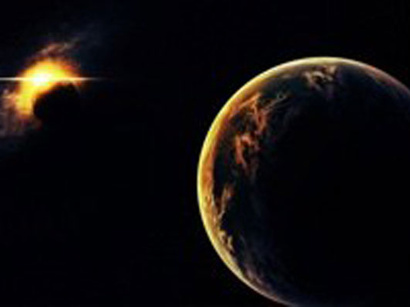Solar eclipse to be seen in Baku late afternoon on Nov.3

By Sabina Idayatova
Residents of Azerbaijan's capital Baku will be able to observe a
solar eclipse at 17:24 on November 3, an astrophysical observatory
official has said.
"The solar eclipse will be visible in Baku in the late afternoon, five to ten minutes before sunset. The lower part of the solar disk will begin to darken during this time. We will be able to observe this phenomenon for eight or nine minutes," deputy director on scientific research of Shamakhi Astrophysical Observatory of the Azerbaijan National Academy of Sciences, (ANAS), Khidir Mikayilov, explained.
The solar eclipse will begin at 14:06 and end at 19:28, Mikayilov said, adding that basically it can be observed across the equator, partly in Africa and the Americas.
According to Mikayilov, a lunar eclipse will begin in the early morning hours of October 19 -- at 02:51 and end at 06:48.
"This time it will be impossible to see it with a naked eye. The process will be able to be recorded only by very sensitive devices," Mikayilov said.
Solar eclipse occurs when the Moon passes between the Sun and Earth, and fully or partially blocks the Sun. This can happen only at new moon, when the Sun and the Moon are in conjunction. In a total eclipse, the disk of the Sun is fully obscured by the Moon. In partial and annular eclipses only part of the Sun is obscured.
An eclipse is a natural phenomenon. Nevertheless, in some ancient and modern cultures, solar eclipses have been attributed to supernatural causes or regarded as bad omens. A total solar eclipse can be frightening to people who are unaware of its astronomical explanation, as the Sun seems to disappear during the day and the sky darkens in a matter of minutes.
As looking directly at the Sun can lead to permanent eye damage or blindness, special eye protection or indirect viewing techniques are used when viewing a solar eclipse.
A lunar eclipse occurs when the Moon passes directly behind the
Earth into its shadow. This can occur only when the Sun, Earth, and
Moon are aligned exactly, or very closely so, with the Earth in the
middle. Hence, a lunar eclipse can only occur the night of a full
moon. The type and length of an eclipse depend upon the Moon's
location relative to its orbital nodes.
Unlike a solar eclipse, which can only be viewed from a certain
relatively small area of the world, a lunar eclipse may be viewed
from anywhere on the night side of the Earth. A lunar eclipse lasts
for a few hours, whereas a total solar eclipse lasts for only a few
minutes at any given place, due to the smaller size of the moon's
shadow. Also, unlike solar eclipses, lunar eclipses are safe to
view without any eye protection or special precautions, as they are
no brighter than the full moon itself.
Here we are to serve you with news right now. It does not cost much, but worth your attention.
Choose to support open, independent, quality journalism and subscribe on a monthly basis.
By subscribing to our online newspaper, you can have full digital access to all news, analysis, and much more.
You can also follow AzerNEWS on Twitter @AzerNewsAz or Facebook @AzerNewsNewspaper
Thank you!
